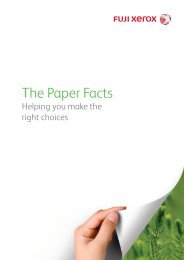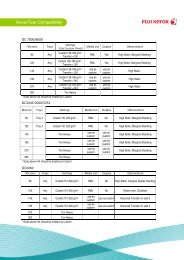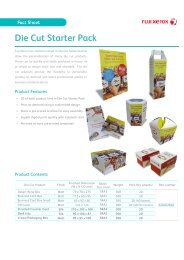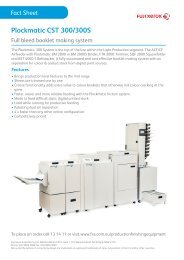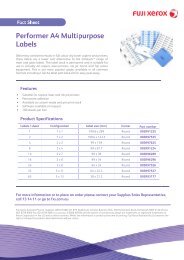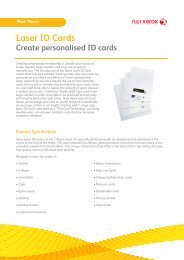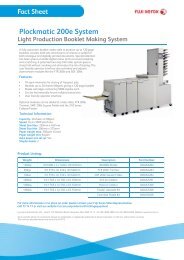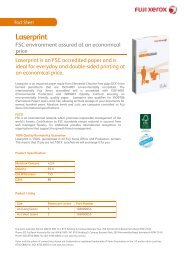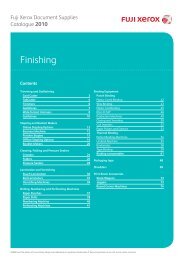Fuji Xerox Australia - Fuji Xerox Supplies
Fuji Xerox Australia - Fuji Xerox Supplies
Fuji Xerox Australia - Fuji Xerox Supplies
Create successful ePaper yourself
Turn your PDF publications into a flip-book with our unique Google optimized e-Paper software.
<strong>Fuji</strong> <strong>Xerox</strong> <strong>Australia</strong><br />
Sustainable Paper Purchasing Policy<br />
VERSION 2 May 2010
Objective<br />
<strong>Fuji</strong> <strong>Xerox</strong> is committed to<br />
responsible paper production,<br />
procurement and use. We<br />
have a long-term commitment<br />
to improving sustainability<br />
performance – our own, our<br />
industry and our customers. Our<br />
vision is to achieve sustainable<br />
outcomes for all stakeholders.<br />
Our aim is to demonstrate and<br />
promote compliance with recognised<br />
social and environmental standards<br />
and ensure our products meet<br />
community expectations of<br />
responsible product stewardship.<br />
Ultimately, we believe it is in<br />
the interests of our industry to<br />
demonstrate responsible stewardship<br />
through the full product life cycle<br />
to verify paper as a socially and<br />
environmentally responsible<br />
communication medium. The<br />
<strong>Fuji</strong> <strong>Xerox</strong> <strong>Australia</strong> sustainable<br />
purchasing strategy is one tool to<br />
achieve this objective.<br />
Scope<br />
<strong>Fuji</strong> <strong>Xerox</strong> <strong>Australia</strong> has developed this policy to apply<br />
to all suppliers of paper products for its <strong>Australia</strong>n<br />
operations and paper distribution business.<br />
This policy covers inputs to the paper production<br />
process, emissions and waste from paper production<br />
and the social context of paper production.<br />
Specifically it covers; fibre sourcing, energy use and emissions, bleaching, water consumption<br />
and emissions, emissions of dangerous chemicals (dioxins, NOx, SOx), solid waste disposal,<br />
compliance with laws, responsible working conditions, transparency, community and<br />
stakeholder relations. We place special emphasis on supplier management of fibre sourcing,<br />
carbon management, legal compliance and transparency. <strong>Fuji</strong> <strong>Xerox</strong> <strong>Australia</strong> expects<br />
all suppliers to be compliant with the minimum and to be moving toward our preferred<br />
requirements in a reasonable timeframe. We will review suppliers each year based on<br />
compliance with our preferred criteria and commitment to continuous improvement. This<br />
review will be a consideration in our purchasing decisions.<br />
INPUTS<br />
• Fibre<br />
• Water<br />
• Energy<br />
OUTPUTS<br />
• GHG<br />
• Other air<br />
• Water<br />
• Landfill<br />
PRODUCTION<br />
• Management<br />
• Bleaching<br />
SOCIAL CONTEXT<br />
• Labour<br />
• Children<br />
• Workplace<br />
• Community<br />
• Legal compliance<br />
• Transparency<br />
Figure 1: Scope of Paper Sourcing Policy
Background<br />
As a leading participant<br />
in the <strong>Australia</strong>n paper<br />
and office equipment<br />
market, <strong>Fuji</strong> <strong>Xerox</strong><br />
<strong>Australia</strong> has a role in<br />
promoting responsible<br />
product stewardship.<br />
We believe that our<br />
suppliers are responsible<br />
companies who, like<br />
us, are striving to<br />
improve their social<br />
and environmental<br />
performance.<br />
In this policy we set some ambitious<br />
objectives we would like the paper and<br />
paper supply industry to achieve. We also<br />
set out steps that allow us to work with<br />
suppliers along a pathway of continuous<br />
improvement. The step-wise approach<br />
sets out minimum requirements to<br />
participate in the <strong>Fuji</strong> <strong>Xerox</strong> <strong>Australia</strong><br />
supply chain, our preferred requirements<br />
and our long term objectives for suppliers.<br />
In setting out this approach, we are hoping<br />
to let our suppliers know where we believe<br />
the industry standard is today and where<br />
it is heading. Within a reasonable period,<br />
we expect all suppliers to achieve our<br />
preferred requirements and to continue to<br />
progress toward our long term objectives.<br />
While this is important to our position in<br />
the market, we also believe it is important<br />
for the whole industry to be able to<br />
demonstrate how it meets community<br />
expectations. Over time, we expect the<br />
industry to transition to full life cycle<br />
accountability for paper. In support of<br />
this approach, <strong>Fuji</strong> <strong>Xerox</strong> <strong>Australia</strong> will be<br />
tracking and reporting our own impacts<br />
through our annual sustainability report,<br />
and encourage suppliers to do the same.<br />
In deciding which issues we should use as<br />
the basis of this policy, <strong>Fuji</strong> <strong>Xerox</strong> <strong>Australia</strong><br />
has examined best practice in social and<br />
environmental reporting; issues that have<br />
been identified by social and environmental<br />
stakeholders as being important and, issues<br />
for which measures exist.<br />
For some of these issues there are more<br />
developed measures than for others.<br />
In general, we are seeking to link our<br />
requirements with existing standards<br />
and measures which many responsible<br />
suppliers are already adopting (such<br />
as ISO accreditation, certification and<br />
sustainability reporting). We expect that<br />
for companies who share our objectives<br />
and who are already tracking performance<br />
and reporting to stakeholders, there will be<br />
virtually no additional effort required to<br />
establish compliance with our policy. For<br />
those who fall short, and do not respond<br />
to requests for improvement within three<br />
months, the commercial relationship will<br />
be reviewed with a view to rectifying the<br />
issues or failing that, terminating the<br />
relationship.<br />
<strong>Fuji</strong> <strong>Xerox</strong> <strong>Australia</strong> has identified a<br />
hierarchy of conformity schemes and<br />
measures (Figure 2). While for some<br />
indicators we will accept measures from<br />
the bottom tier of the hierarchy, our<br />
longer term objective is that when these<br />
are available, our preference is for top<br />
tier conformity programs. As a result,<br />
our step-wise approach includes both<br />
a transition to more comprehensive<br />
measures of performance and a<br />
transition to higher quality measures and<br />
indicators. The following section details<br />
the individual issues and performance<br />
measures sought by <strong>Fuji</strong> <strong>Xerox</strong> <strong>Australia</strong><br />
from companies wishing to comply with<br />
this standard.<br />
Figure 2: Under standing Assessment Schemes
Management Standards<br />
We expect the companies we deal with to be certified to Quality Management Standard ISO 9001<br />
and Environmental Management Standard ISO 14001.<br />
Fibre Sourcing<br />
1<br />
Our minimum<br />
requirement is for<br />
paper that is produced<br />
using either new<br />
plantation fibre or<br />
recycled fibre.<br />
2<br />
Our preferred<br />
requirement is that<br />
paper uses recycled<br />
fibre or new fibre<br />
that is sourced from<br />
sustainably managed<br />
plantations and forests<br />
certified to a recognised<br />
standard. A recognised<br />
standard may be Forest<br />
Stewardship Council<br />
(FSC), Program for<br />
Endorsement of Forest<br />
Certification (PEFC)<br />
or other credible local<br />
certification program.<br />
3<br />
Our objective is that<br />
all suppliers of paper<br />
should hold a valid<br />
Chain of Custody<br />
certificate and products<br />
use recycled fibre or new<br />
fibre is sourced from<br />
sustainably managed<br />
plantations and forests<br />
certified to a stakeholder<br />
endorsed standard.<br />
This would include FSC<br />
and some PEFC forest<br />
certification schemes<br />
such as PEFC UK.<br />
Figure 3: Fibre Sourcing Hierarchy<br />
Recycled or new<br />
plantation fibre<br />
Recycled or new<br />
fibre from certified<br />
plantations<br />
or forests<br />
Recycled or new fibre<br />
from plantations or<br />
forests certified<br />
to stakeholder<br />
endorsed standard
Energy management<br />
1<br />
Our minimum<br />
requirement is that<br />
suppliers will monitor<br />
and report carbon<br />
emissions from their<br />
operations in line with<br />
recognised accounting<br />
frameworks (such as<br />
CEPI, NACSI, GHG<br />
Protocol).<br />
2<br />
Our preferred<br />
requirement is that<br />
suppliers have their<br />
carbon emissions<br />
verified by a third party<br />
auditor; benchmark their<br />
performance and have<br />
strategies to reduce<br />
carbon emissions to best<br />
practice levels.<br />
3<br />
Our objective is that<br />
suppliers undertake a<br />
life cycle assessment<br />
of carbon emissions;<br />
have this verified by<br />
a third party auditor;<br />
have strategies to<br />
monitor and reduce<br />
carbon emissions to best<br />
practice levels, and; are<br />
working with suppliers<br />
and customers to reduce<br />
the carbon footprint of<br />
their product. The lack of<br />
a consistent, standardsbased<br />
LCA / carbon foot<br />
printing methodology<br />
for the forestry, pulp and<br />
paper sectors is noted.<br />
<strong>Fuji</strong> <strong>Xerox</strong> <strong>Australia</strong><br />
would commend<br />
those willing to take a<br />
leadership position and<br />
enable the comparison<br />
of similarly framed<br />
carbon data across<br />
different suppliers’<br />
products.<br />
Figure 4: Carbon Emissions Hierarchy<br />
Carbon emissions<br />
monitored<br />
and reported<br />
Carbon emissions<br />
verified, benchmarked<br />
and strategies in<br />
place to achieve best<br />
practice performnce<br />
Verified life-cycle<br />
analysis benchmarked,<br />
strategies to achieve<br />
best practice, working<br />
with supplier and<br />
customers to reduce<br />
footprint
Other emissions to air<br />
1 2<br />
The minimum<br />
requirement is that<br />
significant emissions<br />
to air such as NOx and<br />
SOx are monitored and<br />
reported by weight<br />
per tonne of paper<br />
manufactured.<br />
Our preferred<br />
requirement would<br />
be that emissions<br />
are verified and<br />
benchmarked at or<br />
close to best practice<br />
for the industry.<br />
3<br />
Our objective would<br />
be zero emissions of<br />
these substances.<br />
Monitor and report<br />
ozone depleting,<br />
dioxins and furans,<br />
SOx, NOx<br />
AOX emissions<br />
verified and<br />
benchmarked at or<br />
close to industry<br />
best practice<br />
Zero emissions<br />
Figure 5: Other Emissions to Air Hierarchy
Water use<br />
1 2<br />
Our minimum<br />
requirement is that<br />
suppliers report on<br />
water scarcity within<br />
the catchment of the<br />
production facility. Ideally<br />
average annual rainfall<br />
and average monthly<br />
rainfall over the preceding<br />
12 month period as well<br />
as observations such as<br />
drought, shortages and<br />
declining water tables<br />
would be monitored and<br />
a complete response to<br />
the issue water availability<br />
would also be provided.<br />
Water consumption per<br />
tonne of production is<br />
also a requested metric.<br />
In water scarce<br />
catchments, our<br />
preferred requirement<br />
would be that suppliers<br />
benchmark their<br />
performance and report<br />
on measures to reduce<br />
their consumption (such<br />
as the percentage of<br />
water recovered and<br />
reused in the production<br />
process) and any impact<br />
their operations may<br />
have on the catchment.<br />
3<br />
Our longer term<br />
objective would be<br />
that, in addition to<br />
the above, producers<br />
in water scarce<br />
catchments measure,<br />
track and verify their<br />
water footprint,<br />
implement water<br />
efficiency measures<br />
and conform to<br />
the requirements<br />
of emerging water<br />
stewardship initiatives.<br />
Report on scarcity<br />
in production<br />
catchment and<br />
consumption per<br />
unit of production<br />
In water scarce<br />
catchments,<br />
benchmark<br />
and report on<br />
measures to reduce<br />
consumption<br />
In water scarce<br />
catchments, verify<br />
water footprint and<br />
conform to emerging<br />
stewardship<br />
initiatives<br />
Figure 6: Water Use Hierarchy
Emissions to water<br />
1<br />
Our minimum<br />
requirement is that<br />
suppliers measure and<br />
report on discharges<br />
to water against Total<br />
Suspended Solids (TSS)<br />
and either Biochemical<br />
Oxygen Demand (BOD)<br />
or Chemical Oxygen<br />
Demand (COD).<br />
2<br />
Our preferred<br />
requirement is that<br />
companies report on<br />
TSS and COD and<br />
benchmark their<br />
performance against<br />
best practice.<br />
3<br />
Our objective is for<br />
suppliers to achieve<br />
industry best practice<br />
in terms of emissions<br />
to water.<br />
Measure and report<br />
onTSS or COD<br />
Measure, report<br />
and benchmark<br />
performance onTSS<br />
and COD<br />
Industry<br />
best practice<br />
Figure 7: Emissions to Water<br />
Bleaching<br />
1<br />
The minimum<br />
requirement for our<br />
suppliers is that they will<br />
use an Elemental Chlorine<br />
Free (ECF) process.<br />
ECF<br />
Figure 8: Bleaching Hierarchy<br />
ECF or PCF<br />
2<br />
Our preferred<br />
requirement is that<br />
they will use a Process<br />
Chlorine Free (PCF) if<br />
it is a recycled pulp or<br />
a Totally Chlorine Free<br />
(TCF) process if it is a<br />
virgin pulp process.
Social Context<br />
(and that the company<br />
1 2<br />
Our minimum<br />
requirement is that<br />
suppliers are compliant<br />
with relevant ILO<br />
conventions (or national<br />
equivalent) relating<br />
to child labour; forced<br />
labour and working<br />
conditions. We expect<br />
our suppliers to keep a<br />
record of relevant local<br />
laws that apply to their<br />
operation and to be<br />
compliant with those<br />
laws. We recognise that<br />
in some countries there<br />
is a conflict between<br />
complying with local<br />
laws and complying with<br />
ILO conventions and will<br />
take this into account<br />
providing suppliers<br />
have exercised what a<br />
reasonable person would<br />
regard as their best<br />
efforts to balance these<br />
competing demands<br />
is not subject to any<br />
human rights complaints<br />
from stakeholders). We<br />
expect the company<br />
to report publicly if it is<br />
found to have breached<br />
either the relevant ILO<br />
conventions or local laws.<br />
3<br />
Our preferred<br />
requirement is that<br />
suppliers are compliant<br />
members of the<br />
United Nations Global<br />
Compact.<br />
Our objective would<br />
be for suppliers to be<br />
certified to an auditable<br />
standard such as<br />
SA 8000.<br />
Compliant with<br />
ILO conventions<br />
on child labour<br />
and working<br />
conditions as well<br />
as local laws<br />
Compliant with<br />
requirements of<br />
UN Global<br />
Compact<br />
Compliant with SA<br />
8000 or similar<br />
Figure 9: Social Context Hierarchy
Solid waste to Landfill<br />
1<br />
Our minimum<br />
requirement is that<br />
suppliers measure<br />
and track their waste<br />
to land fill (per unit of<br />
production).<br />
2<br />
Our preferred<br />
requirement is that this<br />
is reported publicly and<br />
benchmarked against<br />
industry performance.<br />
3<br />
Our objective is for<br />
suppliers to achieve<br />
industry best practice in<br />
terms of waste to landfill<br />
per unit of production.<br />
Measure and report<br />
waste to landfill<br />
on a per unit of<br />
production basis<br />
Measure, publicly<br />
report and benchmark<br />
performance on waste<br />
to landfill per unit<br />
of production<br />
Industry<br />
best practice<br />
Figure 10: Waste to Landfill Hierarchy<br />
Transparency<br />
Our preferred<br />
1 2 3<br />
Our minimum<br />
requirement is<br />
that suppliers make<br />
information available on<br />
all of the issues covered<br />
by this policy.<br />
requirement is that our<br />
suppliers produce a report<br />
to stakeholders based on<br />
the framework set out<br />
by the Global Reporting<br />
Initiative (GRI).<br />
Our objective would be<br />
that suppliers prepare<br />
annual reports that are<br />
independently audited<br />
to the AA1000 (2008)<br />
assurance standard<br />
and compliant with the<br />
reporting framework of<br />
the GRI.<br />
Information<br />
available on<br />
issues covered<br />
by this policy<br />
GRI base annual<br />
report to<br />
stakeholders<br />
Audited GRI<br />
report annually<br />
Figure 11: Transparency Hierarchy
Verification<br />
Suppliers who are compliant with <strong>Fuji</strong> <strong>Xerox</strong> <strong>Australia</strong> preferred requirements<br />
or above can demonstrate their compliance by submitting the relevant reports<br />
listed below. Companies that only meet the minimal requirements may be asked<br />
to host a verification audit by <strong>Fuji</strong> <strong>Xerox</strong> <strong>Australia</strong> staff or an auditor acting on<br />
our behalf. Documentation to support each of the measures itemised above is<br />
summarised below.<br />
Issue<br />
Documentation<br />
1 Management Copy of ISO 9001 and ISO 14001 certification.<br />
2 Fibre Certification approval number, scheme, other documentation that may be relevant,<br />
scope of certification and any corrective action requests issued in the previous audit.<br />
3 Carbon Copy of audited carbon accounting report and policy or strategy document setting<br />
out steps to reduce carbon emissions and/or carbon footprint.<br />
4 Bleaching Details of bleaching process used in manufacture.<br />
5 Other emissions<br />
to air<br />
AOX emissions benchmarked, fines and other penalties imposed by relevant regulator<br />
such as EPA.<br />
6 Water use Summary report on water catchment issues, plant consumption per unit of production<br />
and, in water scarce catchments, strategy and/or policy to reduce water consumption.<br />
7 Water emissions Report on TSS and COD performance, benchmarking report, fines and any other<br />
penalties imposed by regulatory authorities (e.g. EPA).<br />
8 Solid Waste Report on water per unit of production, benchmark report, strategies or policies to<br />
reduce waste.<br />
9 Social Context UN Global Compact report and/or SA 8000 certification documents.<br />
10 Transparency Copy of GRI based report. Where this report covers requirements listed above,<br />
pages highlighted and annotated.
About <strong>Fuji</strong> <strong>Xerox</strong> <strong>Australia</strong><br />
Celebrating its 50th year of operation in <strong>Australia</strong>, <strong>Fuji</strong> <strong>Xerox</strong> is the industry’s leading provider of integrated document services. The company offers<br />
a range of technology solutions and business services to meet our customers’ needs for the effective management of information, from creation<br />
through to production, distribution and capture.<br />
With knowledge and capabilities to design and implement document services for a variety of business needs across offices, print rooms, commercial<br />
printers and publishers, <strong>Fuji</strong> <strong>Xerox</strong> <strong>Australia</strong> has expertise in document management, digitising data, print, office supplies, software solutions and<br />
managed services.<br />
The company, its management and staff are driven to create sustainable value for its stakeholders and this is reflected in our commitment to<br />
environmental responsibility and continuous improvement across all areas of our business.<br />
13 14 12<br />
www.fujixerox.com.au<br />
<strong>Fuji</strong> <strong>Xerox</strong> <strong>Australia</strong> Pty Ltd. ABN 63 000 341 819.<br />
<strong>Australia</strong>n Head Office: 101 Waterloo Rd, Macquarie Park NSW 2113.<br />
Phone (02) 9856 5000 Fax (02) 9856 5003<br />
XEROX, and the sphere of connectivity design are trademarks or registered trademarks of<br />
<strong>Xerox</strong> Corporation in the U.S. and or other countries. Whilst the information is correct at the<br />
time of printing, <strong>Fuji</strong> <strong>Xerox</strong> <strong>Australia</strong> Pty Ltd ABN 63 000 341 819 expressly disclaim that<br />
savings targets from one customer environment may not be necessarily applicable to a<br />
different customer environment. Quality Endorsed Company ISO 9001:2000. QEC1950/01<br />
SAI Global, Certified Environmental Management ISO 14001:2004. C10094 SAI Global.<br />
<strong>Fuji</strong> <strong>Xerox</strong> <strong>Australia</strong> would like to keep you informed of future products and services and<br />
promotional offers. If you do not wish to receive this information, you can contact us via our<br />
website http://www.fujixerox.com.au/contact_us/jsp or by phone 13 14 12 to request this.<br />
Printed in <strong>Australia</strong>, May 2010.<br />
Environment<br />
ISO 14001<br />
Protecting the environment is a fundamental component of our<br />
company’s commitment to corporate citizenship. At <strong>Fuji</strong> <strong>Xerox</strong><br />
<strong>Australia</strong>, we supply products that have been designed with both<br />
our customers and the environment in mind. As a world leader in the<br />
development of parts and components Remanufacturing Programs,<br />
we have made Eco Manufacturing an integral part of our business.<br />
All our sites have achieved ISO 14001:2004 Environmental<br />
Management System Certification, as a demonstration of our<br />
commitment to protecting the environment.





